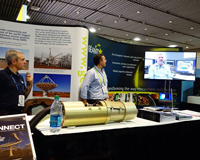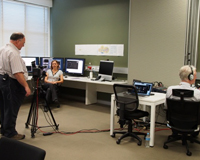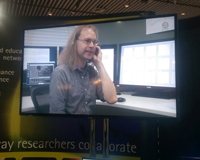ASKAP streams in to Supercomputing 2014
20 November 2014
This week, delegates of the Supercomputing 2014 (SC14) conference in New Orleans had a chance to visit the Murchison Radio-astronomy Observatory (MRO) and chat with ASKAP team members via a series of live links between the exhibition hall and the Science Operations Centre at the Sydney headquarters of CSIRO Astronomy and Space Science.
SC14 brings together the most respected minds in high performance computing, networking, storage and analysis to debut the research and innovation that will open the door to new scientific and economic opportunities.
This year, the key theme to SC14 was ‘HPC Matters’ – using high performance computing capabilities to engage in important conversations around how HPC can influence lives and communities around the world both now and into the future.
Through CSIRO’s involvement in the the international Square Kilometre Array (SKA) project, particularly our work with the SaDT (Signal and Digital Transport) Consortium, the ASKAP team joined forces with colleagues at GÉANT to conduct a series of live crosses to the exhibition hall of the conference.
In six 30 minute blocks, members of the ASKAP commissioning team in Sydney spoke to conference delegates, explaining what ASKAP is and the importance of the instrument as a precursor for the SKA project, while remotely controlling the ASKAP antennas.
On a separate screen, delegates were able to see a high-definition image of the MRO while the ASKAP antennas moved towards a source in a live demonstration of real-time observations with the telescope.
With data streaming in from the six antennas of the Boolardy Engineering Test Array (BETA), the ASKAP team members explained how raw data – flowing from each antenna at approximately 2 Tb/s – is distilled down to a level that can be processed using the Galaxy supercomputer at iVEC Pawsey Centre. Examples of the recent images being produced by the telescope as part of BETA commissioning activities were also shown.
The live crosses have been an important way to connect with the international community and to demonstrate key features of ASKAP, including the high-speed fibre link connecting the MRO to the rest of the world, the ability to control and ‘drive’ the ASKAP antennas remotely from the Science Operations Centre in Sydney (over 3000km away), and the wide field-of-view enabled by the phased array feed (PAF) receivers.
The links also emphasise the collaborative nature of the SKA R&D consortia, with engineers and scientists working together across international borders to design the SKA telescope.
CSIRO is involved in 7 of 11 SKA R&D consortia, including the SaDT consortium, which designs the data transport networks between the elements of SKA.
Back to Latest ASKAP News page.



